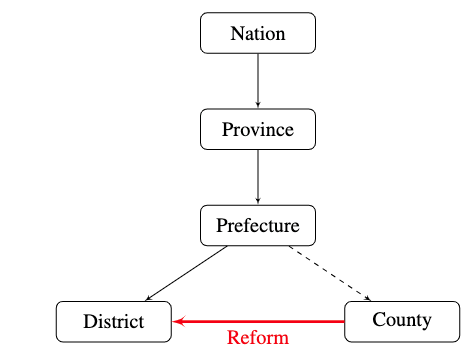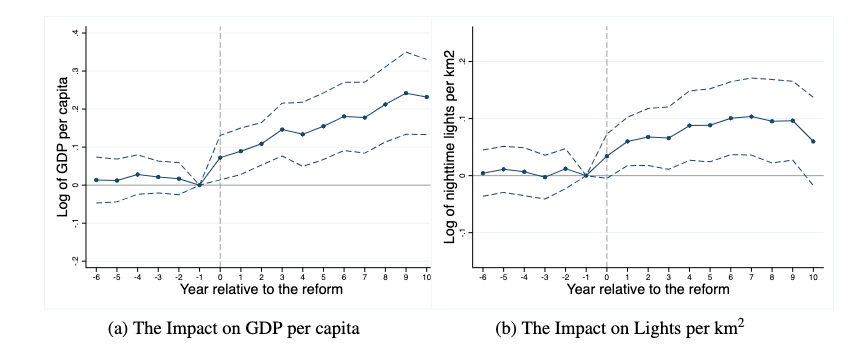Interregional Barriers and Economic Growth in China
We investigate the effects of a policy reform that removed interregional market barriers by incorporating counties into larger prefecture-level divisions. Utilizing a difference-in-differences approach, we compare the economic performance in incorporated counties to two control groups: those that applied but failed to incorporate, and those incorporated later. The findings reveal an immediate and sustained positive impact on economic growth in the incorporated counties. Firm-level data suggest that the reform reduced policy-induced frictions, enhancing regional specialization in industries with comparative advantages, and increasing the entry of new firms while prompting the exit of low-margin firms. The research highlights the importance of reducing interregional market barriers to fostering economic growth in China.

In recent years, the issue of local protectionism has sparked significant debate among policymakers and economists. While the reduction of national-level trade barriers, such as tariffs and quotas, is well-documented, the impact of local protectionism within countries remains less explored. These barriers, including local subsidies, discriminatory regulations, and restrictions on cross-regional trade and migration, can lead to resource misallocation and impede economic growth (Young 2000; Poncet 2005; Barwick, Cao, and Li 2017; Tombe and Zhu 2019). This article examines the effect of reducing these interregional barriers in China through a reform that integrated counties into larger prefecture-level divisions (che xian she qu, 撤县设区).

Figure 1. Government structure in China and the che xian she qu reform
Prior to the reform, Chinese counties were independent administrative entities with their own local governments, while prefecture-level divisions (hereafter “prefectures”) were higher-level units overseeing regional policies and intercounty coordination. This structure often resulted in regulatory and administrative barriers between counties and prefectures, leading to inefficient resource allocation. The incorporation reform merged counties into their overseeing prefectures, transforming county governments into agencies of the prefecture-level government. The centralization aimed to create more integrated and efficient local markets. By integrating counties into larger prefecture-level divisions, the reform sought to eliminate local protectionism that hinders economic growth. This provided an opportunity to study the effects of reducing such barriers on economic outcomes.
To assess the impact of the che xian she qu reform, the study uses a difference-in-differences approach. This method involves comparing incorporated counties (treated) with those that applied but failed to incorporate (control), as well as those incorporated later. This approach allows for a robust analysis by controlling for potential confounding factors and isolating the effects of the reform.
Through comparing the treated counties to the control counties that applied but failed, the study effectively addresses the issue of differences between control and treatment groups. The process of integrating counties into prefectures involves several approval stages. First, both the county and prefecture governments must agree on the incorporation. Then, the proposal must be approved by the provincial government, followed by final approval from central authorities. The provincial government can block the incorporation, often due to incentives to directly administer economically strong counties rather than incorporate them into prefectures. Both incorporated counties and those that applied but failed are typically economically strong, with the decision to incorporate often depending on bargaining between the prefecture and provincial levels, making the difference exogenous to the counties’ economic conditions. Additionally, the central government may block incorporations for noneconomic reasons, such as preserving the status of counties listed as National Famous Historical and Cultural Cities. By using this novel control group, we ensure that the parallel trend assumption in economic development holds for the treated and control counties.
One natural concern for the first approach is that there might still be some other systematic differences between the incorporated counties and the applied-but-failed counties other than changes in policy-induced barriers. To address this issue, we exploit the variation in the timing of the reform as an alternative estimation approach. We employ a difference-in-differences strategy that compares economic growth in counties that experience the current incorporation to counties that would experience the reform several years later, before and after the current reform. Even though the treated counties may not be randomly selected, we show evidence that the timing of the incorporation is arguably exogenous (i.e., no observable characteristics can persistently predict the timing of incorporations).
We utilize county-level panel data from 1995 to 2013, measuring outcomes such as GDP and nighttime light intensity. Nighttime light data, sourced from weather satellites, serve as a robust proxy for economic activity, complementing GDP figures. This approach provides a comprehensive view of the economic impact of the reform, capturing both formal economic output and broader indicators of economic activity.
The reform significantly boosted economic growth in incorporated counties. GDP per capita in these counties increased by 11.7%, and nighttime light intensity per square kilometer rose by 4.8% within ten years of the reform. These results suggest that reducing interregional barriers can lead to substantial economic gains. Importantly, the positive impact remained significant even when considering potential confounding factors such as other contemporary policy reforms and involuntary migration of economic activity.

Figure 2. The impact of market integration on economic development
Note: The figure plots point estimates and 95% confidence intervals for the effect of incorporation reform on GDP and nighttime lights before and after the reform. Outcome variables are the log of GDP per capita or the log of nighttime lights per km2.
Several mechanisms contribute to these results. The reform reduced interregional trade barriers, evidenced by increased geographic concentration in industries with high shares of state-owned enterprises. By reducing local protectionism, the reform facilitated more efficient allocation of resources and greater market integration.
Treated counties showed a shift toward more productive sectors, aligning with comparative advantage theory. This reallocation was driven by the reduction in administrative barriers and increased market access, allowing regions to specialize in industries where they had a competitive edge.
Furthermore, the reform facilitated greater firm dynamism, with a noticeable rise in the entry of new firms and the exit of less profitable firms. This increased competition and turnover contributed to overall economic efficiency, as resources were reallocated to more productive uses.
By highlighting the positive effects of China’s che xian she qu reform, this study contributes to the broader discourse on market integration and economic development. It provides empirical evidence that reducing interregional barriers can lead to substantial gains in local economic growth and efficiency. These findings offer valuable insights for policymakers seeking to promote economic integration and growth in other contexts.
References
Barwick, Panle Jia, Shengmao Cao, and Shanjun Li. 2021. “Local Protectionism, Market Structure, and Social Welfare: China’s Automobile Market.” American Economic Journal: Economic Policy 13 (4): 112–51. https://doi.org/10.1257/pol.20180513.
Poncet, Sandra. 2005. “A Fragmented China: Measure and Determinants of Chinese Domestic Market Disintegration.” Review of international Economics 13 (3): 409–30. https://doi.org/10.1111/j.1467-9396.2005.00514.x.
Tombe, Trevor, and Xiaodong Zhu. 2019. “Trade, Migration, and Productivity: A Quantitative Analysis of China.” American Economic Review 109 (5): 1843–72. https://doi.org/10.1257/aer.20150811.
Young, Alwyn. 2000. “The Razor’s Edge: Distortions and Incremental Reform in the People’s Republic of China.” Quarterly Journal of Economics 115 (4): 1091–1135. https://doi.org/10.1162/003355300555024.

Latest
Most Popular
- VoxChina Covid-19 Forum (Second Edition): China’s Post-Lockdown Economic Recovery VoxChina, Apr 18, 2020
- China’s Great Housing Boom Kaiji Chen, Yi Wen, Oct 11, 2017
- China’s Joint Venture Policy and the International Transfer of Technology Kun Jiang, Wolfgang Keller, Larry D. Qiu, William Ridley, Feb 06, 2019
- The Dark Side of the Chinese Fiscal Stimulus: Evidence from Local Government Debt Yi Huang, Marco Pagano, Ugo Panizza, Jun 28, 2017
- Wealth Redistribution in the Chinese Stock Market: the Role of Bubbles and Crashes Li An, Jiangze Bian, Dong Lou, Donghui Shi, Jul 01, 2020
- What Is Special about China’s Housing Boom? Edward L. Glaeser, Wei Huang, Yueran Ma, Andrei Shleifer, Jun 20, 2017
- Evaluating Risk across Chinese Housing Markets Yongheng Deng, Joseph Gyourko, Jing Wu, Aug 02, 2017
- Privatization and Productivity in China Yuyu Chen, Mitsuru Igami, Masayuki Sawada, Mo Xiao, Jan 31, 2018
- How did China Move Up the Global Value Chains? Hiau Looi Kee, Heiwai Tang, Aug 30, 2017
- China’s Shadow Banking Sector: Wealth Management Products and Issuing Banks Viral V. Acharya, Jun Qian, Zhishu Yang, Aug 09, 2017




 Facebook
Facebook  Twitter
Twitter  Instagram
Instagram WeChat
WeChat  Email
Email 


